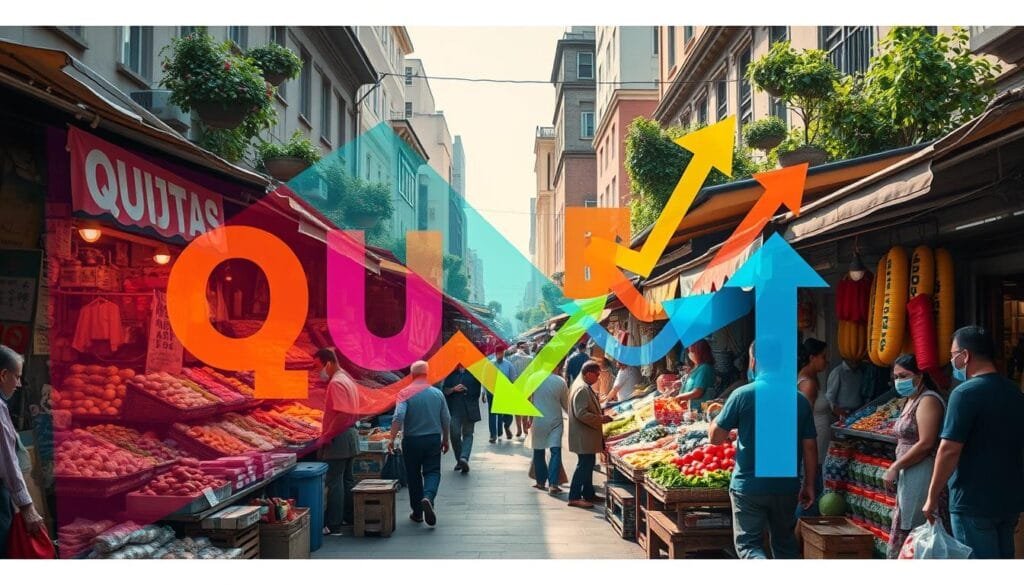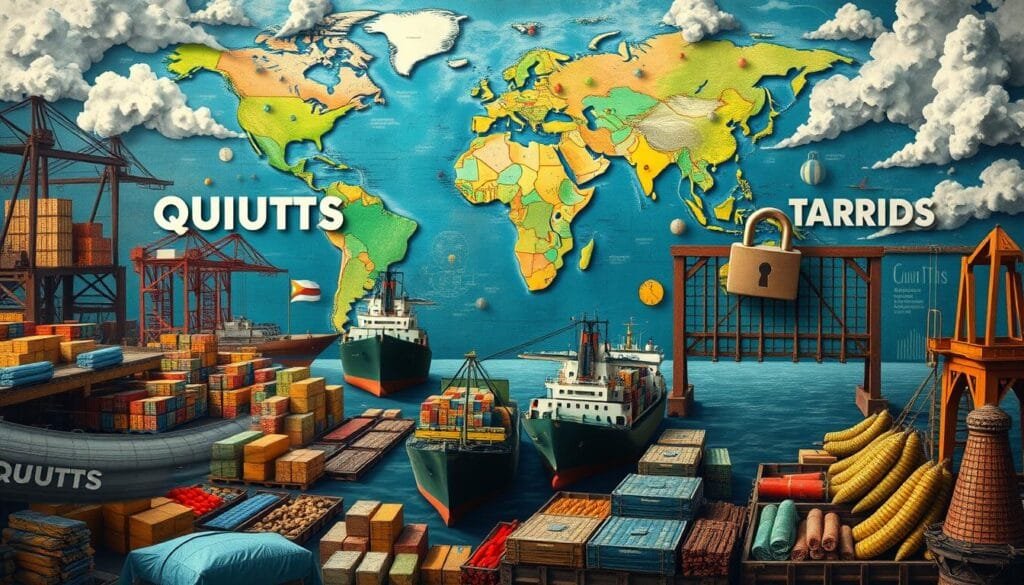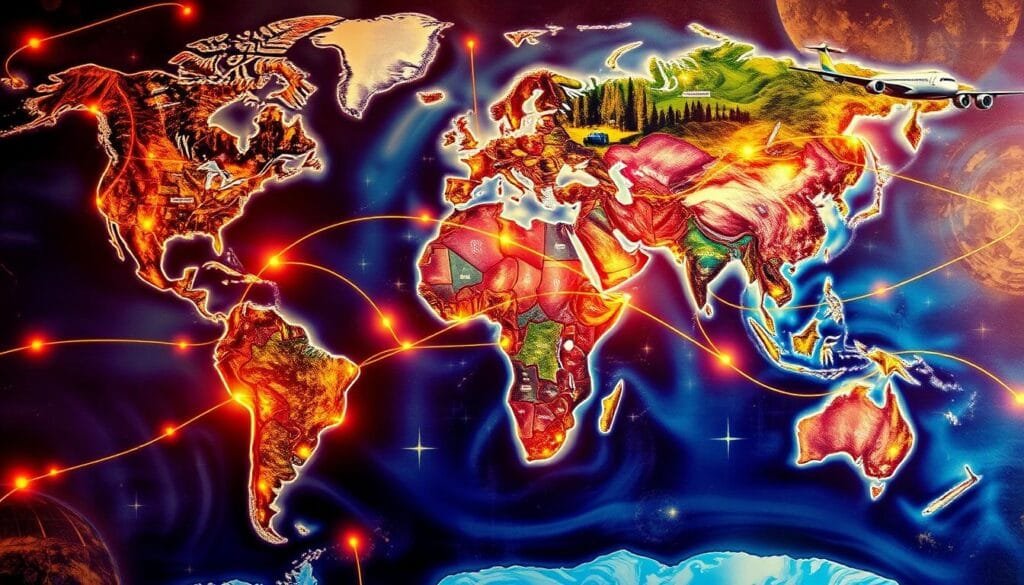When we look at local economies, we see many strategies to help them grow. One key method is economic protectionism. It plays a big part in boosting the growth of domestic markets. Import quotas are one way to do this, and they help manage trade policies. They balance international competition with local industry strength. This is why countries use such strategies.
Import quotas limit how much of certain goods can come into a country. They help our industries by blocking too many imports that are cheaper than local products. These quotas have two main goals. They keep our producers safe and could lead to higher prices and fewer choices for consumers.
Import quotas can really help domestic markets grow. But they come with some downsides. In this guide, we’ve tried to explain how import quotas work. We looked at both the good and the challenging parts. This should give you a better understanding of their impact on the economy.
Key Takeaways
- Import quotas serve as a crucial component of economic protectionism, aimed at reinforcing domestic market growth.
- These trade policy tools limit the supply of imported goods, invariably affecting market prices and consumer choice.
- Quotas help maintain economic stability for domestic industries, shielding them from the influx of often cheaper foreign goods.
- Economic growth can be stimulated through protected industry expansion and job preservation within local markets.
- Varying effects of import quotas, from influencing prices to altering international trade dynamics, reveal their complexity.
- Comparative analysis between quotas and other trade measures, such as tariffs, demonstrates their unique impact on the economy.
- Critical perspectives on implementing quotas draw attention to the challenges and potential drawbacks facing policy makers.
Understanding Import Quotas and Their Role in the Economy
Import quotas are key in the world of non-tariff trade barriers. They help governments control the flow of certain goods. This helps protect local industries and keeps the market safe. By reducing imports, quotas support our producers and keep our economy stable, boosting economic stability.
Quotas put a limit on how much of a product can come into a country. They are especially important in the farming sector for items like dairy and meats. For example, the USDA sets limits on sugar each year. This helps avoid too much sugar in the market and protects our farmers.
Quotas aim to help local businesses by limiting foreign competition. However, they can sometimes cause problems. High levels of lobbying for quotas can waste money that could be used better. In the 1980s, India saw up to 30% of its GDP wasted on such activities. This took a big toll on its economy.
| Region | Quota Item | Effect |
|---|---|---|
| United States | Sugar | Price stabilization & local industry protection |
| European Union | Beef, poultry, butter | Market protection through TRQs |
| India (1980s) | General | Economic drain due to rent-seeking |
The World Trade Organization (WTO) knows quotas can have bad effects, like hurting a country’s economy. They’ve worked to reduce the use of quotas worldwide. Even though tariffs are often less harmful, quotas are still needed when protecting the market and stabilizing prices is important.
Import quotas save local jobs by reducing foreign competition. They create a space where our industries can succeed against global challenges. Quotas also help manage our trade deficit and make wise use of our foreign exchange. They support our economic goals like sustainability and being self-reliant.
By smartly using quotas, countries can balance their trade. This balance is key to keeping our economy stable and growing in the global market. It’s essential for long-term success in today’s connected world.
How do quotas help with economic growth
Quotas manage the supply and demand of imported goods. They help the domestic sector and preserve jobs. By limiting imports, quotas keep prices stable and protect local industries from overseas competition. Let’s explore how quotas boost economic growth.
The Mechanism Behind Quotas and Market Prices
Quotas limit how many goods can be imported. This affects supply and demand, changing prices. For example, quotas on car imports in the U.S. help domestic manufacturers by reducing competition. This supports American jobs and makes the market more predictable, which is vital for planning and investment.
Promoting Domestic Industry and Employment Through Quotas
Quotas are key for policies that support local industries and jobs. They control the flow of foreign products, giving an edge to local businesses. This keeps jobs in the country and makes the economy stable. Agreements like those limiting steel imports from Mexico show how quotas can keep industries healthy and jobs secure.
Case Studies: Quotas’ Impact on Emerging Markets
In countries with emerging economies, quotas are essential. They restrict imports, giving local industries a chance to grow without full overseas competition yet. This supports sectors in these countries, leading to long-term economic success.
The quota on Japanese cars in the 1980s raised import prices by $1300. But it also helped U.S. car makers adjust and grow. Thanks to this, U.S. plants owned by Japanese companies eventually boomed.

| Policy Tool | Impact on Imports | Market Predictability | Price Impact | Job Preservation |
|---|---|---|---|---|
| Quotas | Limits quantity, more restrictive | High | Can increase significantly | Supports domestic jobs |
| Tariffs | Increases cost of imports | Medium | Variable increase | May harm jobs relying on imports |
Quotas, by regulating supply and demand, stabilize prices and support local jobs. They play a crucial role in healthy economies, both in well-established and emerging markets.
The Comparative Effects of Quotas Vs. Tariffs on Economic Growth
In the realm of global trade, tariffs and quotas are key barriers. Each impacts a country’s economy differently. These tools shape how economies grow or shrink.
Tariffs are taxes on imports. They make foreign goods costlier, aiming to boost local products. This increases government revenue and supports local businesses. But, it’s consumers who pay more, which can lower spending and affect industries needing imports.
Quotas, however, limit imported goods. This can make items scarce and pricier, again aiding local businesses. But, this hurts consumers and can reduce market freedom. Quotas might cause short-term shortages and price hikes, possibly raising inflation.
Both measures aim to protect local industries but have complex side effects. They can curb competition, slowing innovation and efficiency. For a deeper look into these effects, this NBER chapter offers insight into trade policy impacts.
- Tariffs help local producers by reducing foreign competition.
- Consumers face higher prices due to tariffs.
- Quotas can cause price jumps and shortages.
- Both tactics can trigger trade wars, affecting growth.
Recent tariffs on metals like steel and aluminum changed global trade patterns. For instance, South Korea and Argentina saw big changes in exports to the US:
| Country | Product | Change in Export Volume 2017-2018 | Change in Export Value 2017-2018 (US$) |
|---|---|---|---|
| South Korea | Steel | -26.2% | -430 million |
| Brazil | Steel | +14.6% | +145 million |
| Argentina | Aluminum | -32.8% | -101 million |
| Vietnam | Flat Steel Products | +79% | Significant increase |
This shows how tariffs and quotas can drastically alter global economies.

In sum, tariffs and quotas defend local businesses. Yet, they bring big economic trade-offs. Finding the right balance with global trade and cooperation is crucial for sound policies.
Challenges and Criticisms of Implementing Quotas
Quotas help with market control and government rules, but they face hurdles and critiques. They can change global trade, affect prices, and availability for buyers. Let’s look at how quotas affect different areas.
Potential Negative Impact on International Trade Relations
Quotas can cause trade fights when seen as unfair by other countries. This may lead to payback, hurting diplomatic talks. The balance of global relations gets shaken, with long-term effects on trade. Quotas are to protect local sectors but might cause trade wars accidentally.
Consumer Costs and Limitations on Market Choices
Quotas impact prices by limiting competition and choice. This can push up prices for some imports, hurting buyer welfare. They support local industry but could raise living costs, affecting buyer happiness and the economy.
Administrative Complexity and the Risk of Market Distortion
Setting up quotas is hard to manage and can twist the market. It leads to more government spending on enforcement and creates bureaucracy. This protection could cut competitiveness and innovation. It might also bring illegal markets, hitting fair trade and economic health.

In the end, quotas aim to protect local industries but come with wide effects. They bring global, administrative, and buyer challenges. These factors alter market structures and economic scenes worldwide.
Conclusion
In our study of trade rules, we see that quotas are important in controlling markets. They help domestic industries by limiting imports. However, this leads to a high cost for consumers. Families spend about $80 billion more because of it. This issue hits harder for those making less than $10,000 yearly.
For example, quotas make milk and dried milk pricier. This puts extra pressure on low-income families. Similarly, the effect of clothing quotas and tariffs is widespread. They act like a hidden tax. This tax costs every American family about $400 each year.
Quotas do have their upsides, like making markets stable. They lessen the risks that come with changing prices. This encourages local producers to improve. They have saved many jobs in the auto industry. Yet, this also means higher prices and possible job losses in other areas.
A study shows that each dollar saved through trade barriers costs the American family $81. This is a big hit to the economy, according to the Federal Trade Commission.
Quotas can protect and help home businesses. They have led to success stories like the 1980s deal with Japan. Yet, using them is complex. They range from car quotas in the past to recent rules on steel. This shows the challenge of protecting local jobs while keeping markets open.
To grow economically, we must carefully use and understand these rules. It’s crucial to keep reviewing and improving our trade policies. This ensures they truly benefit our country’s economy and its people.
FAQ
What is economic protectionism and how does it relate to import quotas?
Economic protectionism helps domestic industries by reducing foreign competition through restrictions. Such restrictions include tariffs and import quotas. Import quotas specifically limit how much of a product can enter a country. This protects local industries from cheap imports and helps domestic markets grow.
How do import quotas serve as non-tariff trade barriers?
Import quotas are non-tariff barriers that cap the amount of goods entering a country. They don’t tax goods but limit their numbers. This helps maintain economic stability and supports local businesses by controlling foreign goods in the market.
Can you explain the mechanism behind quotas and market prices?
Quotas impact prices through supply and demand principles. By limiting imported goods with quotas, the domestic price may increase. This happens because of less competition. It benefits local suppliers who face less foreign competition, changing local market dynamics.
How do quotas contribute to promoting domestic industry and employment?
Quotas keep domestic jobs by limiting cheaper foreign goods’ entry. This evens the playing field for local manufacturers and farmers. It allows them to fairly compete in the market, helping to preserve jobs and support local industries.
What is the impact of quotas on developing economies and their economic policies?
In developing economies, quotas protect young industries from strong foreign competition. They’re part of policies and trade agreements that help grow industries and control trade. This supports the economic development of these markets.
How do the effects of quotas differ from those of tariffs on economic growth?
Quotas and tariffs both restrict trade but in different ways. Quotas control how much can be imported, affecting supply. Tariffs make imports more expensive through taxes, affecting prices. These policies show different ways governments manage trade and support economic growth.
What potential negative impacts on international trade relations can quotas have?
Quotas may worsen international trade relations. Countries might see them as unfair. This can lead to trade wars and tension in diplomatic talks. It affects global trade relations.
How do quotas affect consumer costs and market choices?
Import quotas may increase consumer prices by lowering market competition and choice. This limits imported goods, raising prices. Balancing support for local production with affordable consumer prices becomes challenging.
What administrative complexities and risks of market distortion do quotas introduce?
Quotas add administrative complexity since governments need to ensure compliance. This can raise government costs. Quotas may lead to market issues like black markets, economic inefficiency, and less innovation. This happens because of reduced competition for local industries.
